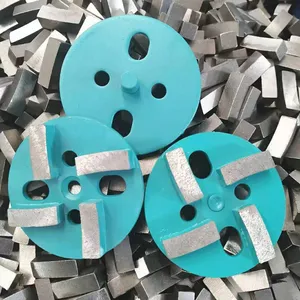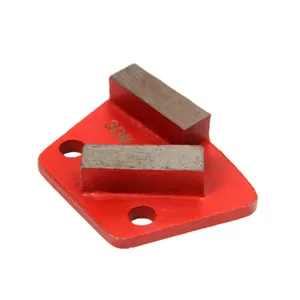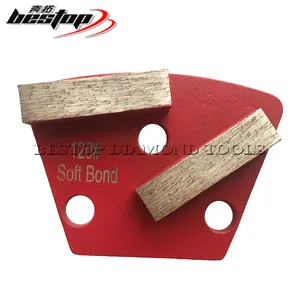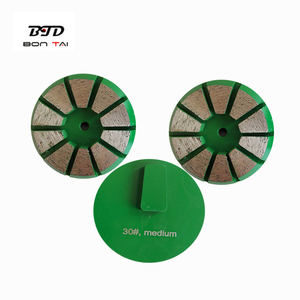Introduction
Selecting the appropriate concrete grinding disc can significantly enhance the efficiency and quality of your work. This guide will navigate you through the complex world of concrete grinding discs, elaborating on their types, applications, and the crucial factors to consider when choosing one. We will explore the specifics of segmented discs, turbo cup discs, and silicon-carbide stones, and how they cater to different tasks. Additionally, we will discuss the importance of material hardness, disc size, grit, and the nature of the job in making the right choice. We will also emphasize safety measures and the significance of proper use and maintenance for achieving optimal results.
Understanding Concrete Grinding Discs
A concrete grinding disc, an integral part of a grinding machine, is utilized for abrasive cutting operations. It's crafted from coarse-particle aggregates like ceramic, silicon carbide, aluminum oxide, or cubic boron nitride. However, diamond is the most prevalent and hardest aggregate used, capable of sanding down surfaces of any hardness. The choice of grinding disc depends entirely on its application. It's inserted into the concrete grinder, then guided over the surface to level it out and eliminate blemishes, resulting in a smooth concrete surface.
Types of Concrete Grinding Discs
Concrete grinding discs are available in various types, each designed for specific tasks. Straight grinding discs are common and used for sharpening tools. Large diameter discs are used for grinding down the outside of round objects. Grinding cup wheels are used to polish stone or concrete, and with a small enough grit, they can handle delicate jobs like paint and adhesive removal. Grinding dish wheels, similar to cup wheels but shallower, fit into tight crevices. Segmented grinding wheels have a segmented abrasive rim, ideal for removing large amounts of material fast. Lastly, cutting face grinding wheels cut through objects by grinding away material.
Segmented Discs
Segmented discs are engineered for medium to heavy stock removal. They have long flat surface segments and an aggressive bond structure, which offers heavy stock removal with a smooth finish. These discs are designed for fast production rates on hard concrete, making them ideal for removing sealer or breaking the glaze on hard troweled floors. The wide gap between segments allows for rapid removal. The design with multiple segments provides longer life and less gouging than a disc with fewer segments.
Turbo Cup Discs
Turbo cup wheels are a type of concrete grinding disc that excels in reaching edges and corners to prepare the concrete substrate for coating or polishing. When paired with a suitable grinder and dust shroud, it can effectively prepare concrete for coating, remove coatings, and even remove glue or mastic. This makes it a versatile and efficient choice for various concrete grinding tasks.
Silicon-Carbide Stones
Silicon-Carbide Stones are a type of semi-flexible disc, known for their durability and unique spiral rib grain pattern. This pattern allows for a fast, cool-cutting action and prevents the loading of removed material on the disc surface. These discs are capable of grinding and finishing in one operation, producing results similar to those of a resin bonded cup wheel. The sharp, hard mineral composition makes them ideal for grinding non-ferrous materials such as marble, granite, terrazzo, concrete, china, clay, enamels, porcelain, and especially fiberglass.
Factors to Consider When Choosing a Concrete Grinding Disc
When choosing a concrete grinding disc, consider the total surface area of the segments, which influences the aggression or speed of the wheel. The segment shape affects the wheel's aggression and dispersion characteristics. The segment bond is critical for the wearing rate and performance on harder surfaces. The grit describes the finishing qualities of the diamond. The lower the number, the coarser the grit. These factors, along with the hardness of the material, disc size, and type of job, will determine the efficiency and lifespan of your concrete grinding disc.
Material Hardness
The hardness of the material you're working with significantly influences the choice of a concrete grinding disc. For instance, concrete made with quartz or basalt aggregate has higher compressive strength than concrete made with pea gravel. Cutting through harder concrete requires a disc with a softer bond, which constantly exposes new abrasives. Conversely, softer materials may require a disc with a harder bond. Understanding the hardness of the material you're dealing with is crucial in selecting the right concrete grinding disc.
Disc Size and Grit
The success of your concrete grinding job depends on the right choice of disc size and grit. Grit is measured in micrometres, with smaller numbers indicating larger diamond particles. For instance, a 30 grit disc has larger particles than a 100 grit disc. Typically, 30 to 40 grit discs are effective for initial grinding, while 80 to 100 grit discs are used for polishing. If you desire a more polished concrete floor, consider using a finer grit. Remember, the choice of grit size also depends on the hardness of the concrete you're working on.
Type of Job
Concrete grinders come in many different sizes and are used in various applications. They can be handheld, walk-behind, or even ridden, powered by gas, propane gas, and electricity. Hand-held grinders offer more maneuverability in smaller areas. Walk-behind grinders are used when large areas of concrete need resurfacing. Rotary grinders are great for jobs that require heavy removal of surface matter, while planetary grinders work great for smaller jobs that don't require heavy concrete restoration. The type of grinder you choose should align with the specific requirements of your job.
Safety and Efficiency
Grinding and polishing concrete come with safety hazards, the most significant being silica dust. This dust is a byproduct of the process and can affect your respiratory system if inhaled. Eye irritation is another risk, as the dust can damage your eyes. It's crucial to use safety goggles and breathing apparatuses during the process. Additionally, maintaining control of your grinding tool is essential for safety and efficiency. Rushing can lead to loss of control, potentially causing harm. Always take a methodical approach to concrete grinding.
Maximizing Efficiency with the Right Disc
Maximizing efficiency with the right concrete grinding disc involves several factors. Knowing the type of job you'll be doing is crucial for selecting the correct product. The size of the disc and the grit are also important considerations. A good general guideline is to select a disc that’s about 1/3 the size of the object you’re trying to grind. The grit determines how aggressive the wheel is, with a higher grit indicating a finer, less damaging wheel. It's always best to start with a lower grit wheel and work your way up as needed.
Proper Use and Maintenance
Ensuring that the grinding wheels function optimally requires careful maintenance and attention. Dressing a grinding wheel is a process done to renew the wheel's surface and restore its original grinding properties. This is done by removing the clogged and worn-out abrasive grains, revealing a fresh layer of grains. Dressing makes sure the wheel remains sharp and free from contaminants, allowing for efficient grinding. By recognizing and addressing common grinding wheel problems, users can maintain the performance and longevity of their grinding wheels. This will lead to better results and less downtime.
Conclusion
In conclusion, the efficiency and lifespan of your concrete grinding disc are determined by several factors, including the type of disc, the hardness of the material, disc size, grit, and the specific job requirements. Understanding these factors is crucial to making an informed choice. Additionally, safety precautions and proper maintenance are key to ensuring optimal performance and longevity of your grinding wheels. By choosing the right disc and using it correctly, you can maximize efficiency, reduce downtime, and achieve a smooth, polished concrete surface.

































 浙公网安备 33010002000092号
浙公网安备 33010002000092号 浙B2-20120091-4
浙B2-20120091-4